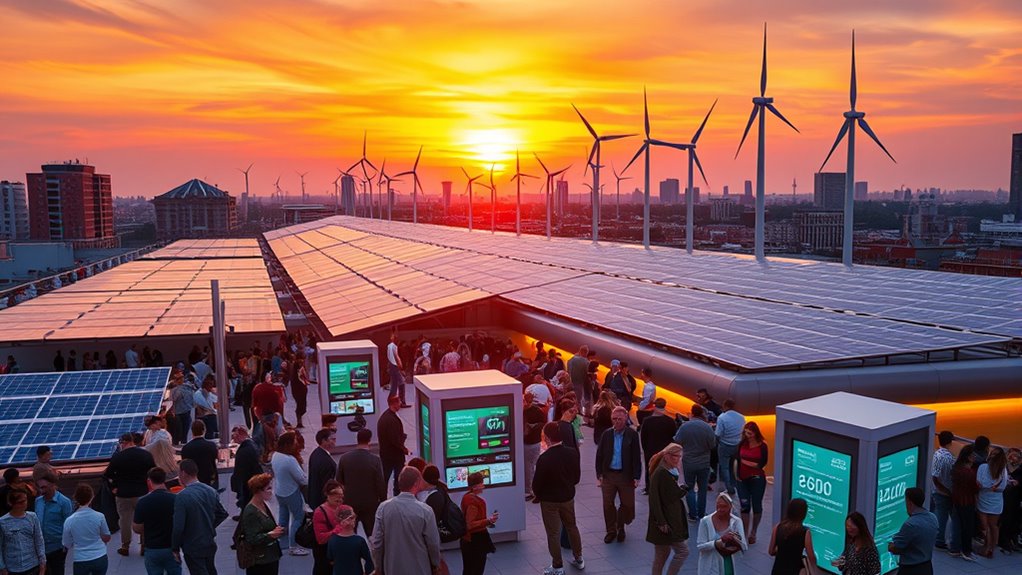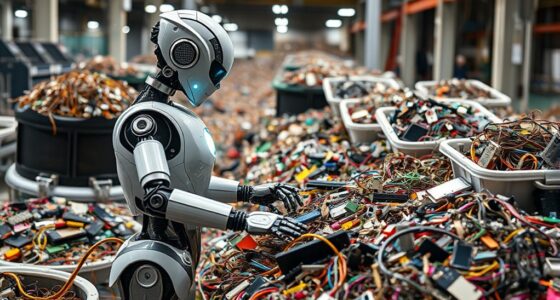Virtual power plants (VPPs) combine many small energy sources like solar panels, wind turbines, and batteries, effectively crowdsourcing electricity supply. They coordinate these distributed resources through smart algorithms and real-time data, allowing you to respond quickly to supply and demand changes. This makes the grid more flexible, stable, and efficient, reducing reliance on fossil fuels. If you keep exploring, you’ll discover how VPPs can revolutionize the future of energy management and sustainability.
Key Takeaways
- Virtual Power Plants aggregate multiple small-scale energy resources to collectively supply electricity, similar to crowdsourcing energy from individual producers.
- They coordinate distributed generators and storage units through smart algorithms, effectively crowdsourcing power to meet demand.
- VPPs leverage consumer-owned assets, turning them into a flexible, crowd-sourced energy network that supports grid stability.
- Crowdsourcing in VPPs enhances renewable integration by pooling decentralized solar, wind, and storage resources.
- This approach creates a resilient, efficient, and scalable energy supply system through collective, crowd-based resource management.

Have you ever wondered how renewable energy sources like solar and wind are managed efficiently? The answer lies in innovative solutions like virtual power plants (VPPs), which use energy aggregation to coordinate multiple small-scale generators and storage units. Instead of relying solely on traditional, centralized power plants, VPPs bring together a network of distributed energy resources, allowing them to operate as a single, flexible power source. This approach enables better grid flexibility, helping utilities respond quickly to fluctuations in supply and demand. When solar panels or wind turbines produce more energy than needed, the excess can be stored or fed into the grid seamlessly. Conversely, during low production periods, energy can be drawn from the aggregated pool to meet consumer needs without causing disruptions.
Energy aggregation plays a pivotal role in making this system work. By combining the capacity of numerous small producers—like residential solar panels, small wind turbines, or battery storage units—VPPs maximize their collective impact. This process involves smart algorithms and real-time data monitoring, which guarantee that each resource is used effectively. When demand spikes or renewable output dips, the VPP can quickly adjust, drawing from stored energy or reducing consumption across the network. This dynamic coordination not only stabilizes the grid but also reduces reliance on fossil fuel-based backup plants, making the entire energy system more sustainable. Additionally, advancements in energy storage technologies enhance the ability of VPPs to manage fluctuations more effectively.
Energy aggregation maximizes the impact of small producers through smart algorithms and real-time data.
Furthermore, VPPs enhance grid flexibility, which is essential as renewable energy sources become more prevalent. The traditional grid was designed for predictable, centralized power generation, but with decentralized sources, variability and unpredictability increase. Virtual power plants address this challenge by acting as a flexible buffer, absorbing excess energy or supplying additional power as needed. Utilities can manage the flow of electricity more precisely, reducing outages and improving reliability. This flexibility also allows for better integration of renewable sources into the existing grid infrastructure, accelerating the transition to cleaner energy.
In essence, virtual power plants empower you as a consumer by making the energy system more resilient and sustainable. They turn numerous small, decentralized energy resources into a coordinated, intelligent network capable of balancing supply and demand efficiently. Through energy aggregation and enhanced grid flexibility, VPPs are transforming how we generate and distribute electricity, paving the way for a more sustainable and reliable energy future. By leveraging these innovations, we can reduce carbon emissions, lower energy costs, and build a smarter, more adaptable grid for generations to come.
Frequently Asked Questions
How Do Virtual Power Plants Impact Local Energy Prices?
You might wonder how virtual power plants influence local energy prices. They can stabilize grid price dynamics by balancing supply and demand more efficiently, which often leads to lower costs. As a result, consumer affordability improves because you’re likely to pay less during peak times. By aggregating distributed energy sources, virtual power plants create a more responsive and cost-effective system, benefiting you through more stable and affordable electricity rates.
What Technology Ensures Security in Crowdsourced Electricity Grids?
Imagine a digital fortress guarding your electricity network. Blockchain security creates an unbreakable ledger, like a chain of glowing links, ensuring transparency and tamper-proof records. Cybersecurity protocols act as vigilant sentinels, constantly monitoring for threats and blocking intruders. Together, these technologies safeguard crowdsourced electricity grids, keeping your energy supply safe and reliable, so you can trust that your power stays steady and secure in this interconnected digital landscape.
How Are Consumer Privacy Concerns Addressed in Virtual Power Plants?
You address consumer privacy concerns by implementing data encryption, which safeguards your personal information from unauthorized access. Additionally, clear consent management guarantees you’re in control of what data is shared and how it’s used. These measures help build trust, making sure your privacy is protected while participating in virtual power plants. By actively managing your consent and securing your data, you can confidently contribute to the system.
Can Virtual Power Plants Operate During Widespread Grid Failures?
During widespread grid failures, virtual power plants face resilience challenges due to infrastructure limitations. You might wonder if they can operate effectively. While VPPs can help restore power more quickly by coordinating distributed resources, their success depends on existing infrastructure’s robustness. If infrastructure is severely compromised, VPPs may struggle to operate fully. Overall, they enhance resilience, but limitations mean they can’t fully replace traditional grid systems during major failures.
What Are the Long-Term Environmental Benefits of Virtual Power Plants?
It’s ironic, isn’t it? You’re helping cut emissions and boost renewable integration while crowd-sourcing electricity. Virtual power plants foster cleaner energy, reducing reliance on fossil fuels. Over time, they lower greenhouse gases and promote sustainable practices. By coordinating distributed resources, you contribute to a healthier planet, making a real difference in environmental preservation. Long-term, these systems support a greener, more resilient energy future for everyone.
Conclusion
By harnessing the collective power of distributed energy resources, virtual power plants are transforming how we generate and manage electricity. Did you know that by 2030, virtual power plants could provide up to 30% of the world’s renewable energy capacity? This innovative approach not only boosts efficiency but also empowers you to be part of a sustainable future. Embracing this technology means you’re helping create a more resilient, eco-friendly power grid for everyone.









